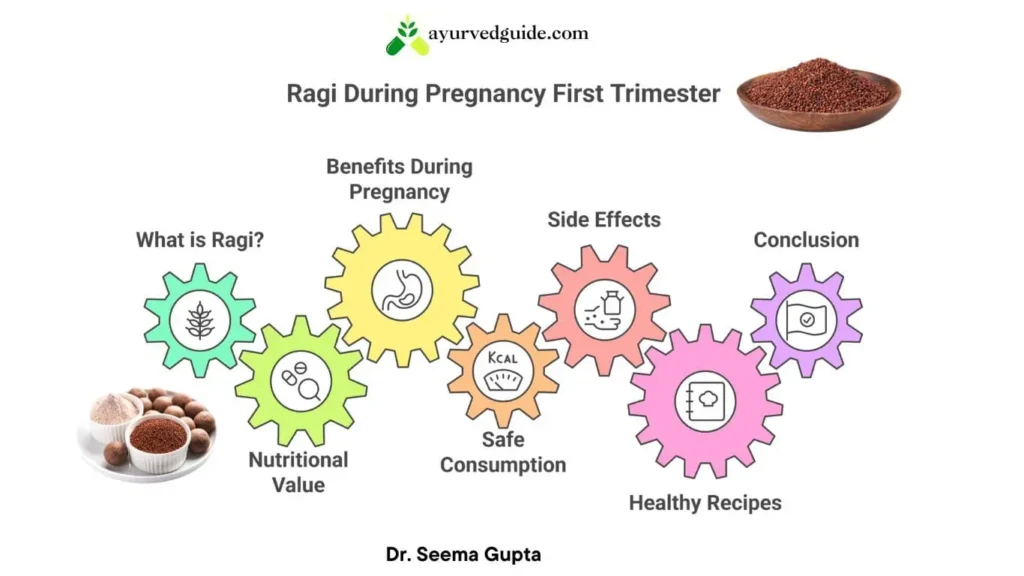
Ragi During Pregnancy First Trimester – Pregnancy is a life-changing experience, and good nutrition is essential for the health of both the woman and the baby. Every vitamin is important in the first trimester because it sets the stage for your baby’s growth. Try ragi – it’s packed with important nutrients and could improve your pregnancy diet.
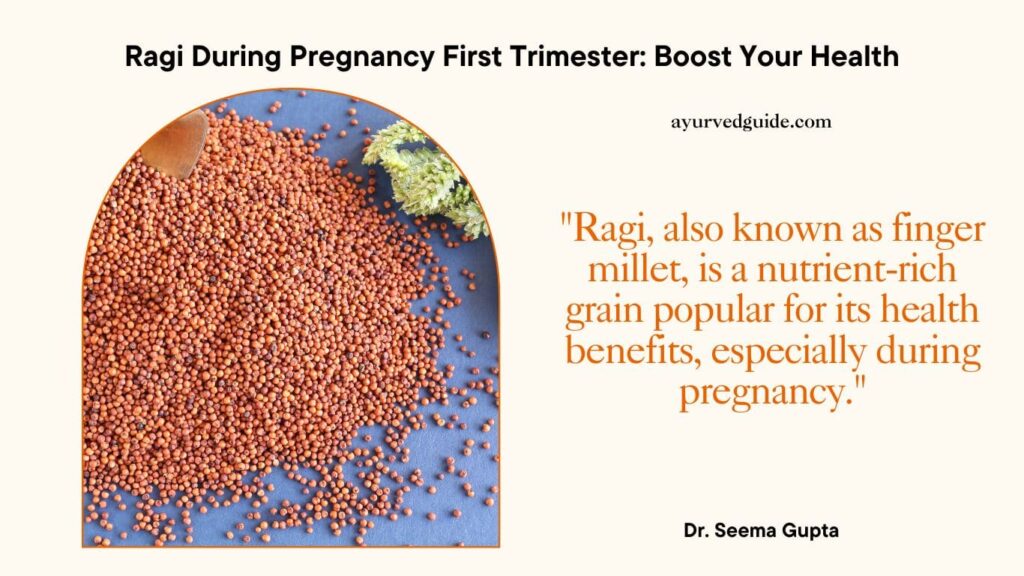
What is ragi, and why is it becoming popular with expecting mothers? Ragi -Finger millet is an ancient grain that has been a key food in many countries for hundreds of years. Its great nutrients make it a possible superfood for pregnant women, especially in the important early months. Many expectant mothers are confused by contradictory information about whether ragi is helpful in the first stage of pregnancy.
“Learn nutrition tips in our Women’s Health Guide.”
In this article, we will learn about ragi and how it affects pregnancy. I will explain the nutrition, benefits, and possible side effects of adding this healthy grain to your diet during pregnancy. I’ll share tasty recipes and answer common questions to help you decide if ragi should be part of your meals in the first trimester.
What is Ragi?
What is Ragi?
Ragi, or finger millet, is a nutritious grain that has been grown for thousands of years in different regions of Africa and Asia. This old grain is very famous in southern India and is a main part of their diet. Ragi is well-known for being highly nourishing and offering many health benefits.
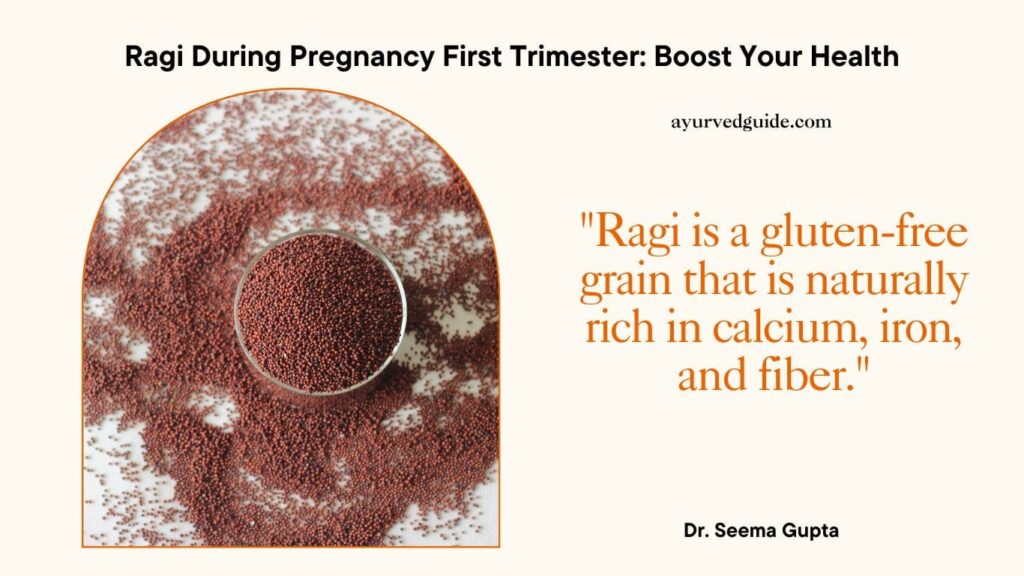
Characteristics of Ragi
- Appearance: Small, round grains with a reddish-brown color
- Texture: Coarse when ground into flour
- Taste: Slightly nutty and earthy flavor
Nutritional Composition
| Nutrient | Amount per 100g |
|---|---|
| Calories | 320 kcal |
| Protein | 7.3g |
| Fiber | 3.6g |
| Calcium | 344mg |
| Iron | 3.9mg |
Ragi is a flexible grain that can be used in many ways when cooking.
- Baking flour
- Porridge or cereal for breakfast.
- You can add this to beverages to make them healthier.
- Used in traditional foods like roti and dosa.
The popularity of it has increased recently because it is gluten-free and may have health benefits. This makes it a great option for people with restrictions on their diet or those looking to eat healthier.
Is Ragi Good for Pregnancy?

Ragi, also known as finger millet, is indeed an excellent addition to a pregnant woman’s diet, especially during the first trimester. Its numerous nutritional benefits make it a valuable food choice for expectant mothers.
Macronutrients and Micronutrients
Ragi has it all. According to the FSSAI, ragi is the richest source of calcium and minerals. It also contains iron, amino acids, and antioxidants mandatory for fetal growth. Regular intake of ragi can help strengthen bones and teeth and also aids in the skeletal development of the fetus.
Ragi contains higher levels of calcium and iron that help stimulate breast milk production and hormonal balance. The rare component methionine present in ragi reduces blood cholesterol, keeping you relaxed, and aids in the overall health of skin and hair.
Nutritional Benefits for Pregnancy – Ragi During Pregnancy First Trimester
Ragi offers a range of essential nutrients that are particularly beneficial during pregnancy:
- High in calcium and iron
- Rich in protein and fiber
- Contains essential amino acids
- Good source of vitamins B1, B2, and B3
Why Ragi is Recommended
Here’s a comparison of ragi with other common grains:
| Nutrient | Ragi | Wheat | Rice |
|---|---|---|---|
| Calcium | High | Low | Low |
| Iron | High | Medium | Low |
| Fiber | High | Medium | Low |
| Protein | High | Medium | Low |
Ragi Benefits for Pregnant Women
- Supports fetal bone development
- Helps prevent anemia
- Aids in digestion and prevents constipation
- Provides sustained energy
Ragi is a healthy food that’s great for pregnant women, benefiting both their health and the baby’s. Its high calcium content is especially important in the first trimester when the baby starts to build its bones. Also, the iron in ragi helps stop anemia, which is a typical issue during pregnancy.
Now that we know how good ragi is for pregnancy, let’s look closely at its nutrition.
Nutritional Value of Ragi
High Calcium Content
Ragi is a great source of calcium, with about 344mg in every 100g. This is much more than most other grains, making it especially good for pregnant women who need more calcium.
Natural Fats
Ragi is low in fat but has healthy fats that are important for fetal brain development and hormone regulation during pregnancy.
Gluten-Free
Ragi is safe for pregnant women who are sensitive to gluten or have coeliac disease. Since it doesn’t contain gluten, it is easy to digest and less likely to cause allergic reactions.
Rich in Minerals
Ragi is packed with essential minerals:
| Mineral | Benefits during pregnancy |
|---|---|
| Iron | Prevents anemia |
| Phosphorus | Supports bone health |
| Magnesium | Reduces muscle cramps |
| Zinc | Boosts immune function |
Helps in Supplying Protein to Various Parts of the Body
Ragi is a good source of protein, which is important for the growth of the baby and the health of the mother. It has a good mix of amino acids, which helps keep you healthy during pregnancy.
Now that we know about ragi’s diet, let’s look at its benefits for pregnant women.
Benefits of Ragi During Pregnancy

![]() Source of essential nutrients
Source of essential nutrients
Ragi is filled with important nutrients that are very beneficial for both mothers and their babies during pregnancy. It contains a variety of minerals, vitamins, and helpful substances:
| Nutrient | Benefit |
|---|---|
| Calcium | Supports bone development |
| Iron | Prevents anemia |
| Fiber | Aids digestion |
| Protein | Promotes fetal growth |
| Vitamin C | Boosts immunity |
Manages insomnia
Expecting mothers often struggle with sleep issues. Ragi contains amino acids that help:
- Regulate sleep patterns
- Reduce anxiety
- Promote relaxation
Enhances breastmilk production
While primarily beneficial in later stages, consuming ragi during the first trimester can set the foundation for improved lactation. Its nutrient profile supports:
- Hormonal balance
- Tissue development for milk production
Prevents gestational diabetes
Ragi’s low glycemic index helps:
- Regulate blood sugar levels
- Reduce the risk of gestational diabetes
Relieves stress
The magnesium content in ragi acts as a natural stress reliever by:
- Calming the nervous system
- Reducing cortisol levels
Controls cholesterol levels
Ragi’s fiber content aids in:
- Lowering bad cholesterol (LDL)
- Maintaining healthy lipid profiles
Prevents anemia
Iron-rich ragi is crucial for:
- Hemoglobin production
- Oxygen transport to the fetus
How Much Ragi is Safe to Eat During Pregnancy?
![]() Recommended Daily Intake
Recommended Daily Intake
Pregnant women can easily eat 50-100 grams of ragi each day. This amount gives important nutrients without overloading the digestive system. It’s important to slowly add ragi to your diet, especially if you’re not used to it.
Factors Affecting Consumption
Several factors influence the safe amount of ragi consumption during pregnancy:
- Individual tolerance
- Overall diet composition
- Existing health conditions
- Trimester of pregnancy
Consumption Guidelines
| Trimester | Recommended Intake | Notes |
|---|---|---|
| First | 30-50 grams/day | Start with smaller amounts |
| Second | 50-75 grams/day | Gradually increase intake |
| Third | 75-100 grams/day | Monitor for any discomfort |
Tips for Safe Consumption
- Start with small portions and gradually increase
- Combine ragi with other nutrient-rich foods
- Consult your healthcare provider before making significant dietary changes
- Listen to your body and adjust intake accordingly
Remember that, while ragi is nutritious, it should be included in a well-balanced diet. Overconsumption might cause digestive problems and interfere with the absorption of other nutrients. Always focus on variety in your pregnancy diet to ensure you’re obtaining an adequate quantity of nutrients for both your and your baby’s health.
Are There Any Side Effects of Ragi During Pregnancy?
Possible Side Effects

Ragi is usually safe and good for you during pregnancy, but you should know about possible side effects:
- Digestive Problems: Some women might feel bloated or constipated after eating an excessive quantity of ragi.
- Blood Sugar Changes: Ragi can reduce blood sugar levels, which might be a worry for pregnant women with gestational diabetes.
- Mineral Absorption: Ragi has phytic acid, which can make it harder for the body to absorb some nutrients.
- Thyroid Issues: Pregnant women with thyroid problems should consult their doctor before adding ragi to their diet.
Safety measures.
To reduce possible side effects and increase benefits, keep these tips in mind:
- Moderation: Eat ragi in moderation as part of a healthy diet.
- Preparation: Before eating ragi, soak or ferment it to lower the phytic acid levels.
- Consultation: Talk to a healthcare provider before making major changes to your food while pregnant.
| Side Effect | Precaution |
|---|---|
| Digestive Issues | Start with small portions and gradually increase |
| Blood Sugar Fluctuations | Monitor blood sugar levels regularly |
| Mineral Absorption | Combine ragi with vitamin C-rich foods |
These side effects can happen, but they are usually uncommon when you eat ragi in moderation. Most pregnant women can easily include ragi in a healthy diet for its nutritional benefits. Everyone is different, so it’s important to pay attention to how your body feels and get professional help if you have any worries.
Healthy Recipes for Eating Ragi in Pregnancy Indian
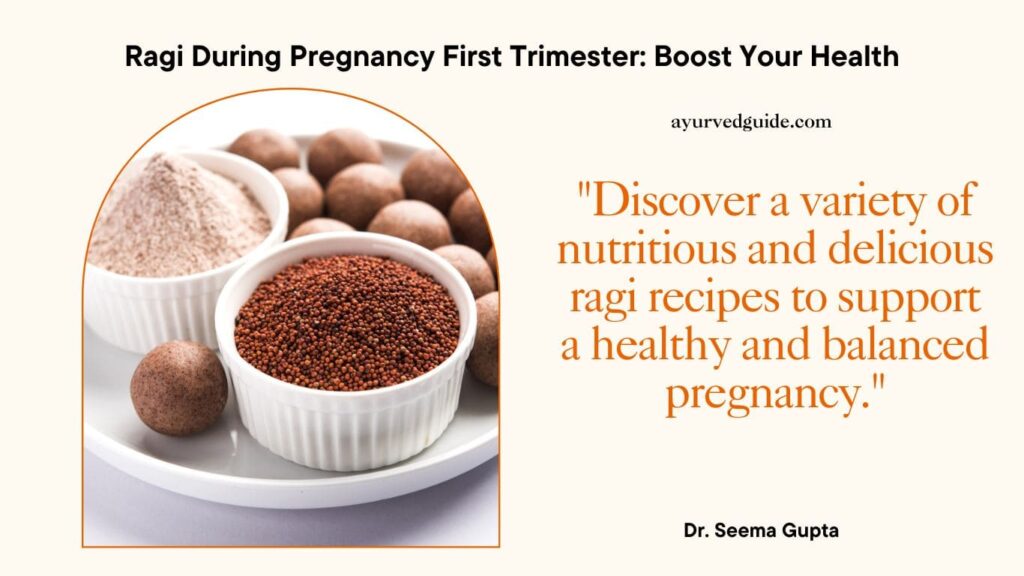
Ragi Dosa
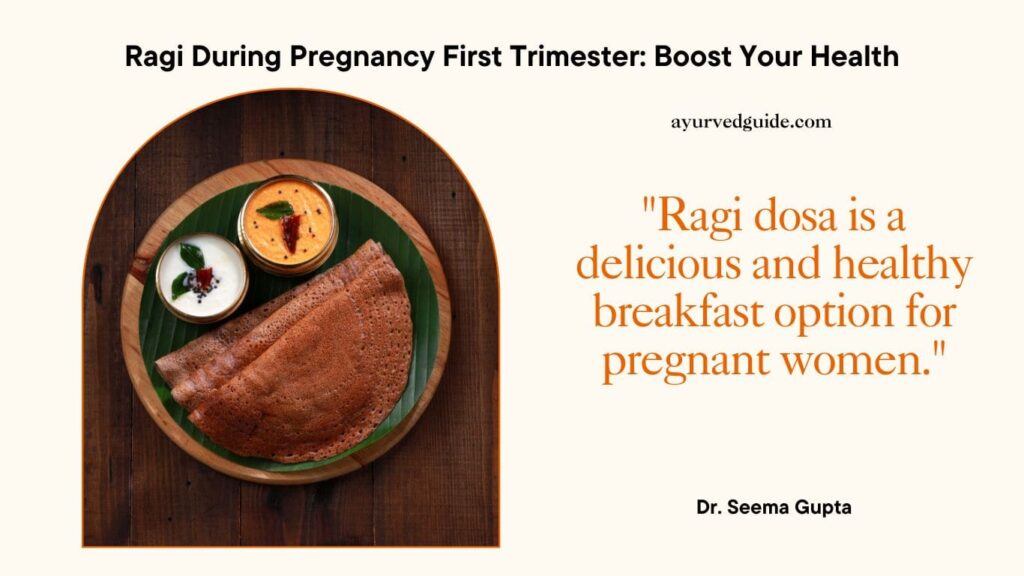
Ragi dosa is a nutritious and delicious option for pregnant women. Here’s a simple recipe:
| Ingredients | Quantity |
|---|---|
| Ragi flour | 1 cup |
| Rice flour | 1/2 cup |
| Cumin seeds | 1 tsp |
| Salt | To taste |
| Water | As needed |
- Mix ragi flour, rice flour, cumin seeds, and salt in a bowl.
- Add water gradually to make a smooth batter.
- Let the batter rest for 30 minutes.
- Heat a non-stick pan and pour a ladleful of batter.
- Cook until golden brown and serve hot with chutney.
Ragi Ladoo Recipe – Ragi Ladoo Recipe with Jaggery
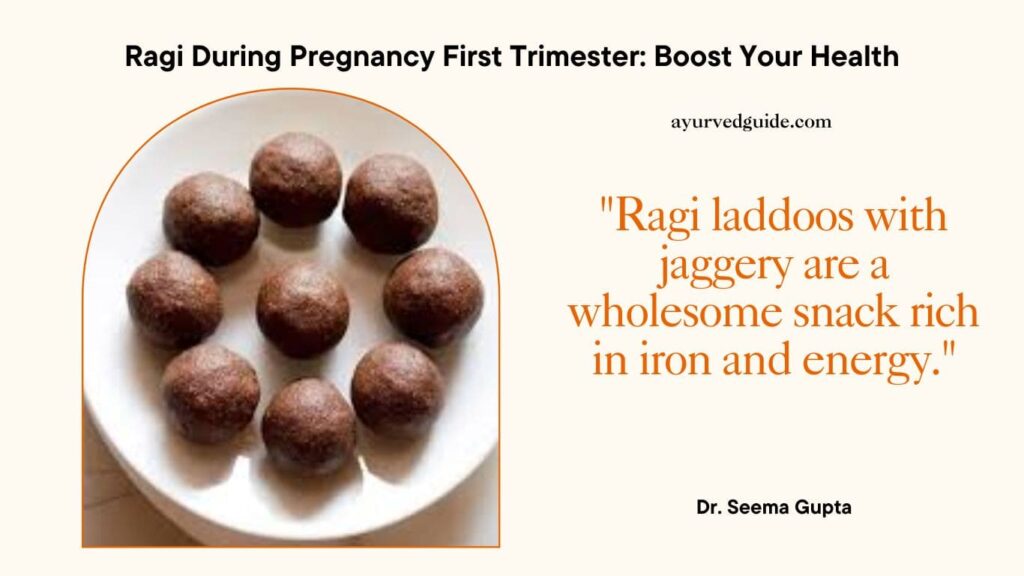
Ragi ladoos are a perfect sweet treat during pregnancy. Here’s how to make them:
- Dry roast 2 cups of ragi flour until fragrant.
- In a separate pan, melt 1/2 cup of ghee and add 1 cup of jaggery.
- Mix the jaggery syrup with the roasted ragi flour.
- Add powdered cardamom and chopped nuts for flavor.
- Shape the mixture into small balls while still warm.
These recipes are a wonderful way to include ragi in your pregnant diet. Ragi dosa provides a savory choice, whereas ragi ladoos fulfill sweet appetites. Both recipes are high in important nutrients, making them suitable for pregnant mothers. Experiment with these recipes to find your favorite way to eat ragi while pregnant.
Ragi Porridge – Ragi During Pregnancy First Trimester
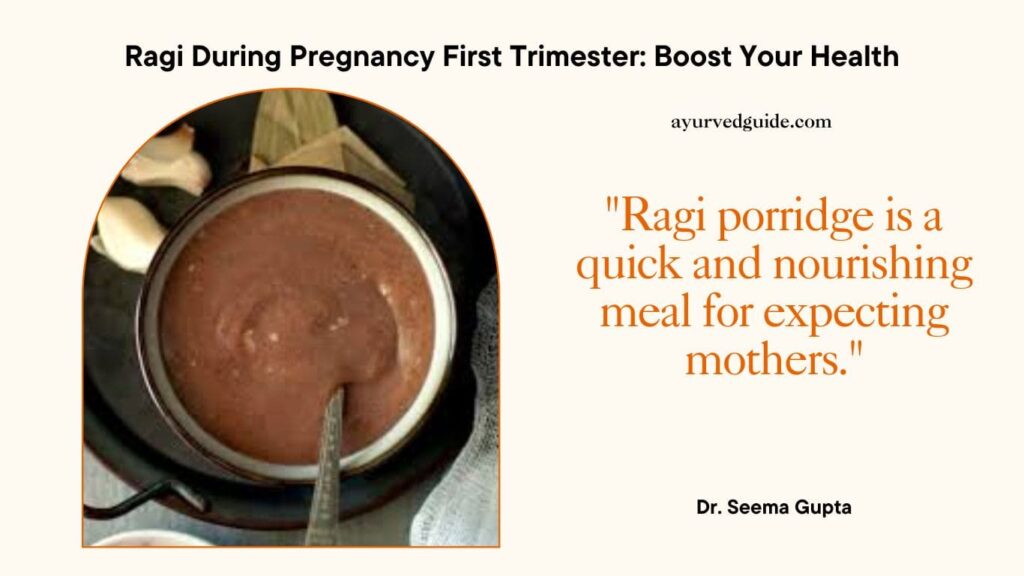
Ingredients:
- 2 cups water
- 1/2 cup ragi flour
- 1 cup milk (dairy or plant-based)
- 2 tablespoons jaggery or honey
- 1/4 teaspoon cardamom powder
- Chopped nuts (optional)
How to Make:
- In a saucepan, bring water to a boil.
- Gradually add ragi flour, whisking continuously to avoid lumps.
- Reduce heat and simmer for 5-7 minutes, stirring occasionally.
- Add milk and continue cooking for another 3-5 minutes.
- Stir in jaggery or honey and cardamom powder.
- Cook for an additional 2 minutes until the desired consistency is reached.
- Serve hot, garnished with chopped nuts if desired.
| Nutrient | Amount per Serving |
|---|---|
| Calories | 150-200 |
| Protein | 5-7g |
| Fiber | 3-4g |
| Iron | 2-3mg |
| Calcium | 150-200mg |
This simple and nutritious ragi porridge recipe is a great way for pregnant women to get more ragi into their diet. Ragi flour mixed with milk gives a well-balanced source of carbohydrates, proteins, and important minerals. The addition of jaggery or honey provides natural sweetness, while cardamom imparts a delightful aroma and flavor. This warm, soothing porridge is not only easy to digest, but it also helps to keep blood sugar constant throughout pregnancy.
Ragi Idli
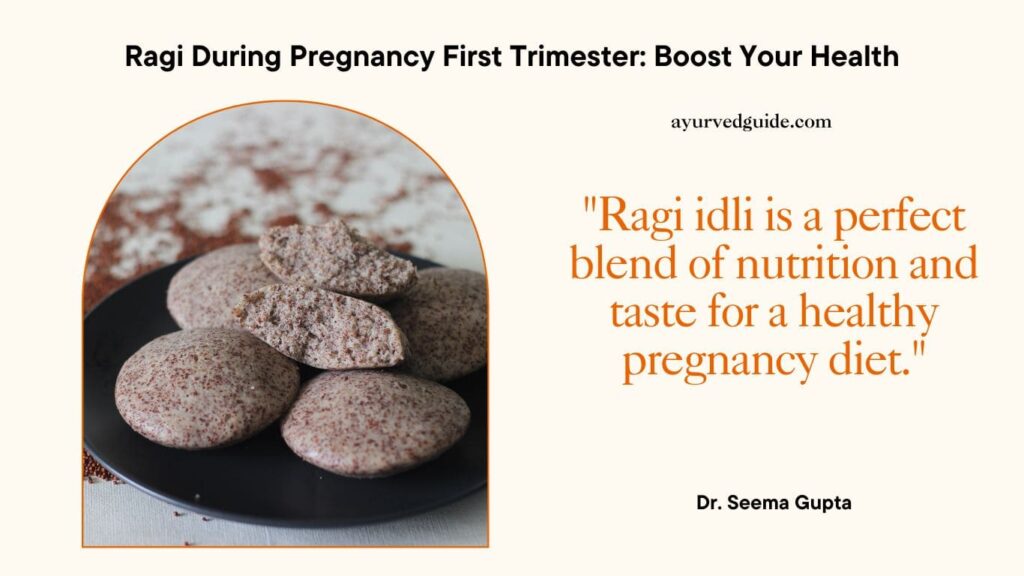
Ingredients:
- 1 cup ragi flour
- 1/2 cup rice flour
- 1/4 cup urad dal (split black gram)
- 1/4 tsp fenugreek seeds
- 1/2 tsp salt (or to taste)
- 1/4 tsp baking soda (optional)
- Water as needed
- Oil for greasing the idli molds
How to Make:
- Soak urad dal and fenugreek seeds for 4-6 hours, then grind into a smooth batter.
- In a bowl, mix ragi flour, rice flour, and salt.
- Add the ground dal batter and mix well. Add water to achieve a thick consistency.
- Let the batter ferment overnight.
- Grease idli molds, pour the batter, and steam for 10-12 minutes. Serve with chutney and sambar.
Ragi Idli is an extremely nutritious food, particularly during pregnancy. It contains vital vitamins, calcium, and iron, which promote fetal development and maternal health. It promotes digestion and keeps energy levels stable because it is gluten-free and easily digestible. This nutritious and tasty dish makes a fantastic addition to a well-balanced diet.
Ragi Roti – Ragi During Pregnancy First Trimester
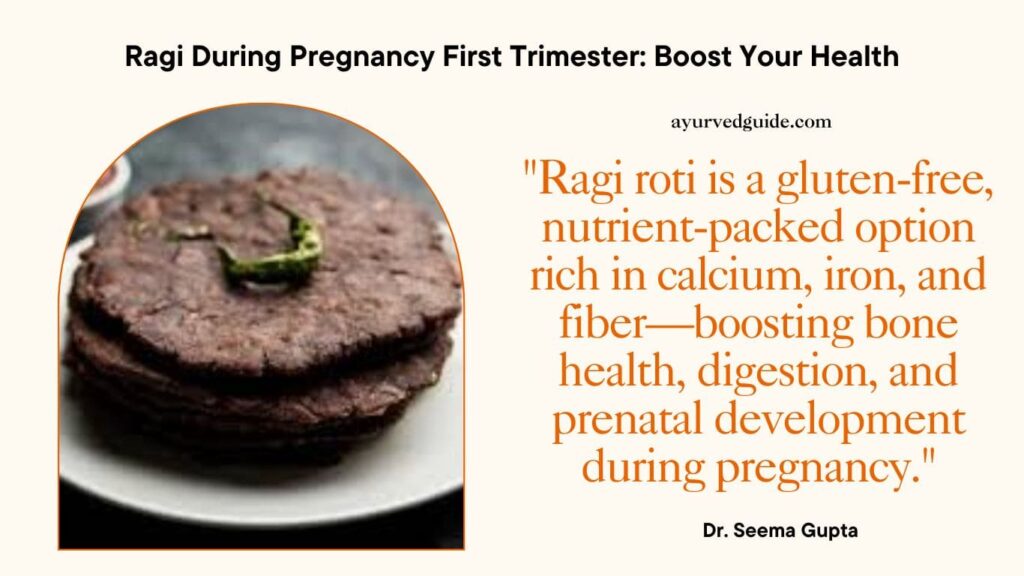
Ingredients:
- 1 cup ragi flour (finger millet flour)
- 1/4 cup whole wheat flour (optional, for texture)
- Water (as needed)
- 1/2 tsp cumin seeds (optional)
- Salt to taste
- Ghee or oil for cooking
How to Make:
- In a mixing bowl, combine ragi flour, wheat flour, cumin seeds, and salt.
- Gradually add water and knead the dough until smooth and soft.
- Divide dough into small balls and roll each into a thin flatbread using a rolling pin.
- Heat a tawa (griddle) and cook the roti, pressing gently, until golden brown on both sides.
- Apply ghee or oil for extra flavor. Serve hot.
Ragi roti is a nutritious and gluten-free alternative high in calcium, iron, and fiber, making it suitable for pregnancy and overall health. It builds bones, improves digestion, and promotes prenatal development. It is simple to create and serves as a nutritious alternative to traditional wheat-based roti, promoting a balanced diet.
Ragi Malt
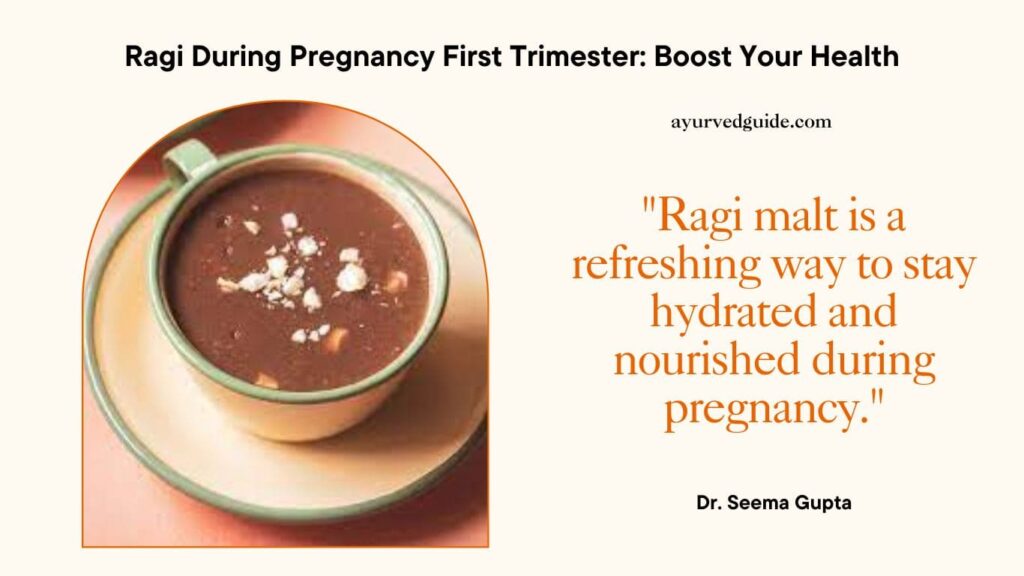
Ingredients:
- 2 tablespoons ragi flour (finger millet flour)
- 1 cup water
- 1 cup milk
- 1-2 teaspoons jaggery or sugar (optional)
- A pinch of cardamom powder (optional)
How to Make:
- In a pan, dry roast the ragi flour for 2-3 minutes.
- Add water and stir continuously to avoid lumps.
- Once the mixture thickens, add milk and continue stirring.
- Let it cook for another 2-3 minutes.
- Add jaggery or sugar and cardamom powder, mixing well.
- Serve hot as a nutritious drink.
Ragi malt is abundant in calcium, iron, and vital amino acids, making it ideal for pregnancy and overall health. It helps to strengthen bones, enhance immunity, and improve digestion. This nutrient-dense drink is also an excellent choice for increasing energy and promoting general health.
Ragi Upma – Ragi During Pregnancy First Trimester
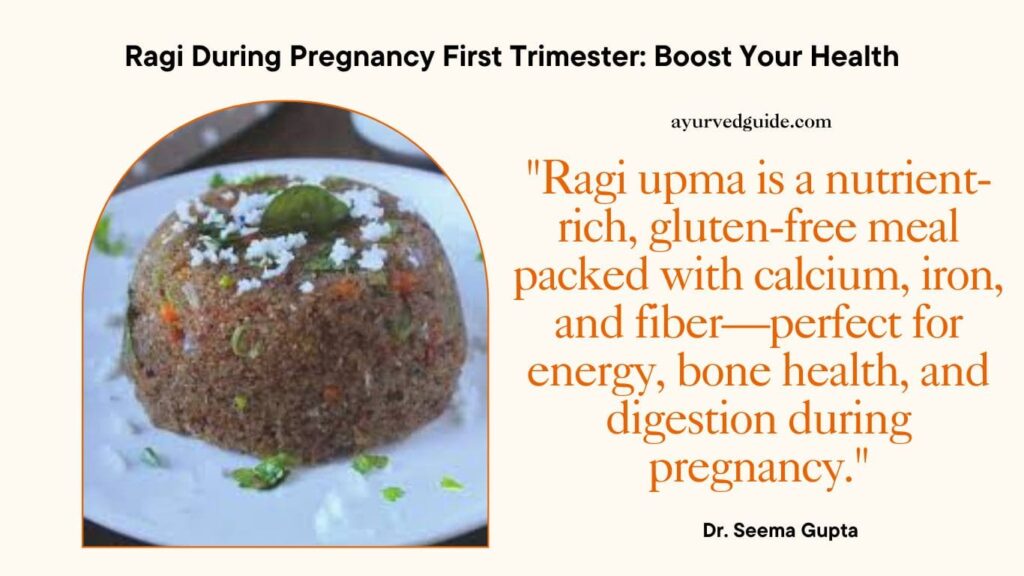
Ingredients:
- 1 cup ragi flour
- 1 tbsp oil or ghee
- 1/2 tsp mustard seeds
- 1/2 tsp cumin seeds
- 1 chopped onion
- 1 chopped green chili
- 1/2 cup mixed vegetables (carrot, peas, beans)
- 1/4 tsp turmeric powder
- Salt to taste
- 2 cups water
- Fresh coriander leaves for garnish
How to Make:
- Heat oil or ghee in a pan, add mustard and cumin seeds.
- Add chopped onion and green chili, and sauté until soft.
- Add vegetables, turmeric, and salt, and cook for 5 minutes.
- Add water and bring to a boil.
- Stir in ragi flour, and cook until thickened. Garnish with coriander. Serve warm.
Ragi upma is a nutrient-dense, gluten-free meal high in calcium, iron, and fiber, making it great for increasing energy and bone health while pregnant. It improves good digestion, regulates blood sugar levels, and serves as a quick, nutritious breakfast alternative for overall well-being.
Ragi Smoothie
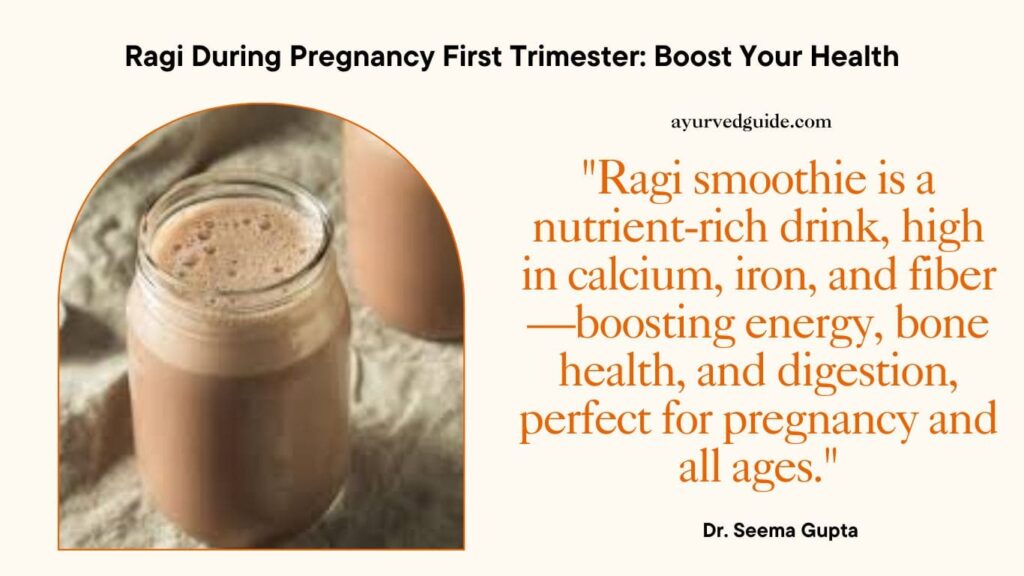
Ingredients:
- 2 tablespoons ragi flour
- 1 cup milk (or plant-based milk)
- 1 ripe banana
- 1 tablespoon honey (optional)
- 1/2 cup yogurt
- A pinch of cardamom powder
- Ice cubes (optional)
How to Make:
- Roast ragi flour lightly in a pan for 2-3 minutes to bring out its aroma.
- In a blender, add roasted ragi flour, milk, banana, yogurt, and honey.
- Blend until smooth.
- Add cardamom powder and blend again.
- Serve chilled with ice cubes for a refreshing drink.
Enjoy this healthy smoothie as a nutritious breakfast or snack.
Ragi smoothie is a nutrient-dense drink that is great for increasing energy and improving overall health. It is high in calcium, iron, and fiber, which benefits bone health, and digestion, and helps you stay full for longer. This recipe is ideal for pregnant ladies, children, and anybody looking for a nutritious, quick meal.
Ragi Pancakes – Ragi During Pregnancy First Trimester

Ingredients:
- 1 cup ragi flour
- 1/2 cup wheat flour
- 1/2 tsp baking powder
- 1 tbsp sugar (optional)
- A pinch of salt
- 1/2 tsp cardamom powder
- 1 cup milk (or as needed)
- 1 tbsp melted ghee or oil
- A few chopped nuts (optional)
How to Make:
- Mix ragi flour, wheat flour, baking powder, sugar, salt, and cardamom powder in a bowl.
- Add milk and ghee, whisking until a smooth batter forms.
- Heat a pan, grease with ghee, and pour a ladle of batter.
- Cook on both sides until golden brown.
- Serve with honey, fruits, or yogurt.
Enjoy this nutritious, energy-boosting breakfast!
Ragi pancakes are a nutritious breakfast option that contains calcium, iron, and fiber. They enhance bone health, aid digestion, and increase energy levels, making them perfect for pregnancy and overall wellness. This recipe is quick, nutritious, and offers a gluten-free alternative to traditional pancakes.
Ragi Mudde
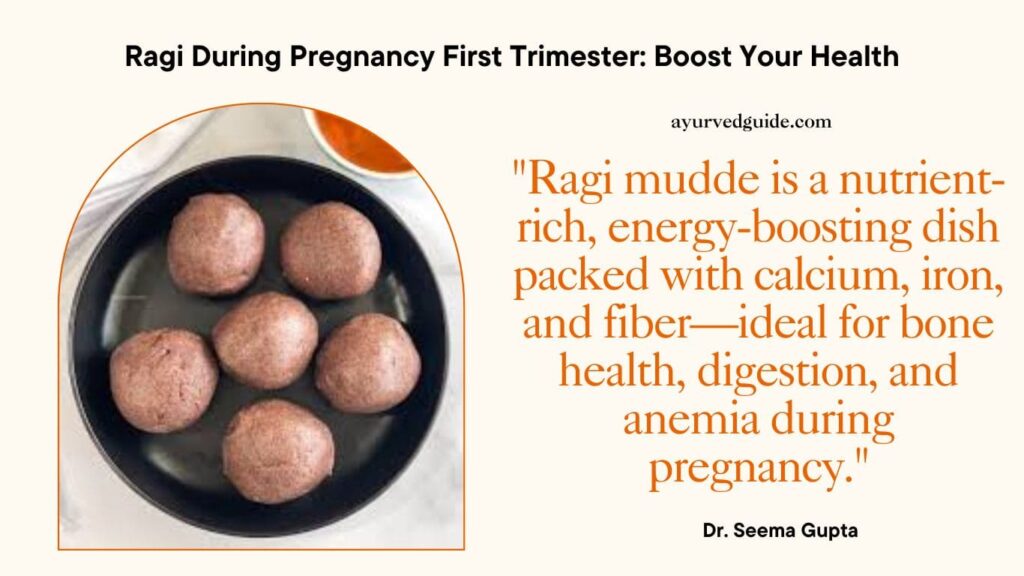
Ingredients:
- 1 cup ragi flour
- 2 cups water
- A pinch of salt
How to Make:
- Boil 2 cups of water in a pan, adding a pinch of salt.
- Gradually add ragi flour while stirring continuously to avoid lumps.
- Cook on low heat, stirring until it thickens and starts to leave the sides of the pan.
- Once done, shape the mixture into small, round balls (mudde) using wet hands.
- Serve with sambar, curry, or any chutney of your choice.
Ragi mudde is a healthy, filling dish rich in calcium, iron, and fiber, suitable for pregnant women. It promotes bone health, reduces anemia, and assists digestion. This recipe gives energy and is an excellent substitute for regular meals, ensuring a healthy, balanced diet throughout pregnancy.
Try these ragi recipes today for a healthier, stronger tomorrow, and get the benefits of this ancient grain in several yummy ways! There’s a recipe for everyone’s taste, whether it’s a filling ragi porridge, a crispy dosa, or a refreshing smoothie. Choose your favorite and incorporate ragi into your daily routine for increased energy, stronger bones, and a nourished body during pregnancy.
How To Make Your Baby Intelligent During Pregnancy and Beyond
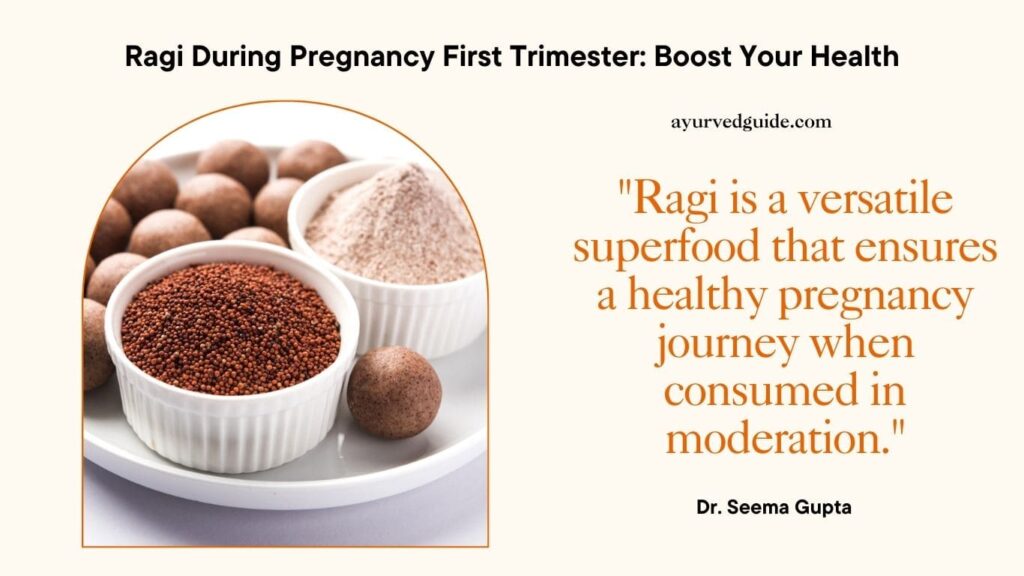
Ragi is an excellent nutritional supplement for pregnant women, particularly in the first trimester. Its high concentration of important elements, such as iron, calcium, and folic acid, makes it an excellent supplement to any pregnancy diet. Ragi has several benefits, including improved digestion, blood sugar regulation, and bone health, which benefit both mother and fetus.
While including ragi in your diet is helpful, moderation is essential. Pregnant women should visit their healthcare experts to establish the right amount of ragi to consume based on their specific needs. Women can enjoy this nutritious grain in a variety of delicious and unique ways during their pregnancy journey by trying out different ragi recipes, including porridge. Including ragi in a balanced diet can lead to a healthier pregnancy and a better start for the developing baby.
FAQ’S
Yes, ragi can be safely consumed during early pregnancy. It’s rich in essential nutrients like calcium, iron, and fiber, which are beneficial for both the mother and the developing fetus.
While ragi is generally safe, some individuals should take caution. People with gluten intolerance or coeliac disease should stay away from ragi because it might not be good for them. People with kidney issues should be careful with ragi because it has a lot of oxalates, which could make their situation worse. People with thyroid problems should see a doctor before adding ragi to their diet.
Ragi is considered to have a cooling effect on the body according to Ayurveda. This makes it particularly beneficial during pregnancy, especially in warmer climates. It helps to lower body heat and is useful during hot weather to keep the body cool. However, moderation is important, as excessive use, particularly during the colder months, can occasionally produce discomfort such as colds or indigestion for people with sensitive systems. Cooking methods such as making ragi porridge with warm spices (ginger or cinnamon) might help balance its cooling effects.
Incorporating ragi (finger millet) into your first-trimester diet can be beneficial due to its rich nutrient profile. It’s high in essential nutrients like iron, calcium, and fiber, which support fetal development and help prevent anemia. Ragi can be consumed in various forms, such as porridge, dosas, or rotis. However, moderation is key, especially if you have thyroid concerns, as excessive intake may interfere with thyroid function. Always consult your healthcare provider before making significant dietary changes during pregnancy
This is a myth. The color of a baby’s skin is determined by genetics, not by the mother’s diet during pregnancy. Ragi consumption does not affect the baby’s skin color.
Yes, ragi contains folic acid, which is crucial for fetal development, particularly in preventing neural tube defects. However, it’s still recommended to take folic acid supplements as prescribed by your doctor.
Craving ragi during the first trimester is normal and healthy. It contains calcium, iron, and fiber, which promotes fetal growth, strengthens bones and assists digestion. Its cooling characteristics and versatility make it ideal for oatmeal, dosas, and malts. Consult your doctor to make sure it suits your pregnant diet.
Ragi is a nutrient-dense food that is especially important during the first trimester. It is high in calcium, iron, and amino acids, which help in fetal bone and muscle growth. Its high fiber content promotes digestion and reduces constipation. Ragi’s cooling properties also help balance body heat, making it a nutritious and safe choice during pregnancy.
While ragi is extremely healthy, excessive consumption during pregnancy might cause digestive discomfort such as bloating or gas due to its high fiber content. Its oxalate content may put vulnerable people at risk of developing renal stones. Pregnant women with thyroid problems should consult their doctor before adding ragi to their diet.
Ragi, which is gluten-free and beneficial to bone health and digestion, has been found to be more nutritious than wheat (atta) because of its higher calcium, iron, and fiber content. Wheat, on the other hand, provides energy-rich carbohydrates, so the choice depends on personal health goals and dietary requirements.
Yes, ragi can be consumed daily during pregnancy because it is extremely nutritious, and filled with calcium, iron, and necessary amino acids. It promotes bone health, fetal growth, and overall wellness. However, it is essential to eat a well-balanced diet and seek specific nutritional guidance from a doctor when pregnant.
Ragi is beneficial to health, but eating too much might cause digestive troubles such as bloating due to its high fiber content. It also includes oxalates, which can affect calcium absorption and be troublesome for people who have kidney problems. Moderation is important for avoiding any negative effects.
Ragi laddu is a healthy and nutritious snack during pregnancy that contains calcium, iron, and vital amino acids for fetal development. It can benefit bone health, increase energy, and aid in lactation. However, because of its high fiber content, excessive consumption might cause stomach discomfort.
Whole wheat flour, oat flour, and ragi flour are all good options during pregnancy. These flours contain vital nutrients such as fiber, iron, calcium, and folic acid, which promote fetal growth, digestive health, and overall well-being. For the best results, use unrefined, whole-grain flour.
Ragi can cause digestive pain in some people, especially when ingested in excess due to its high fiber content. It may also increase oxalate levels, which could impair renal function in patients with pre-existing kidney disorders.
Ragi during the second trimester is useful to pregnant women since it contains important nutrients such as calcium, iron, and magnesium. It improves bone health, prevents anemia, and promotes fetal growth. Consuming ragi regularly can help manage weight and blood sugar levels, improving overall health during pregnancy.
While ragi is normally healthy during pregnancy, excessive use in the third trimester can cause digestive problems such as bloating or constipation due to its high fiber content. To avoid nutrient imbalances or discomfort, it should be consumed in moderation and balanced with other foods.
Dr. Seema Gupta, BAMS, MD (Naturopathy) is an Ex-House Physician in Gynecology and Obstetrics who is Advanced Certified in Diet and Nutrition. with over 27 years of experience in Women’s Health, Ayurveda, Naturopathy, and Diet, she has empowered 70,000+ patients to achieve natural healing. Her expertise in Gynecology and Obstetrics ensures personalized, science-backed advice.
